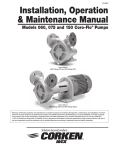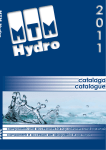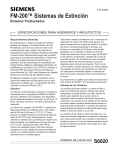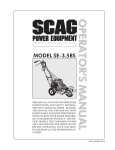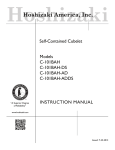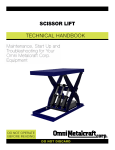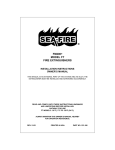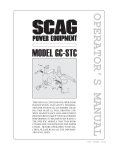Download Pre-Engineered Service Manual FD and MD Models
Transcript
Pre-Engineered Service Manual FD and MD Models Servicing of SEA-FIRE FD and MD Models When a cylinder arrives for service immediately inspect the box for damage before signing to except delivery. Document any damage on receiving documents. We suggest wearing safety glasses and using extreme care when receiving, unpacking and inspecting a returned cylinder. Cylinders damaged during shipment may discharge at any time. Carefully open the box and save it and the packing material then inspect the cylinder for damage. First inspect the manifold/release bracket area for any damage. Damage in this area can cause the cylinder to discharge prematurely if bumped. Be sure the safety pin is in place. If it is not and there is no damage to the release bracket and it can be inserted without force, insert the safety pin. Do not insert the pin if the release bracket is damaged and never attempt to force a safety pin in place. If the release bracket is damaged or the pin cannot be easily inserted, carefully remove damaged release brackets before further handling of the cylinder. After the cylinder is deemed safe to handle complete the inspection of the cylinder. If damaged document the damage. Use pictures to document damage whenever possible. If the damage is determined to have occurred during shipment decide if a damage claim on the carrier will be filed. If so hold the box, packing material and cylinder until the claim is closed. If no claim is to be filed the packing materials can be discarded and the cylinder can be processed as required. Typical damage seen on returned cylinder Identify the cylinder type/model and determine the correct parts needed for use in: Repair of the cylinder Get the model number off the label, (EX. “FD400M”). If there is no label or the label is damaged and the model number cannot be read more information will be needed. Get the agent type from the main label (EX. FM200, HFC227) Weigh and record the cylinder weight. Look at the writing stamped along the top of the cylinder (TPED cylinders have markings around the cylinder just above the base) to identify the cylinder type (EX. TC-3ALM69, DOT39, 3AL1000, 4BW500) and the cylinder manufacture date (EX. 10 08 = October 2008). An alternate method of identification is to match up the dimensions of the cylinder to the cylinder data sheet . DOT39 cylinders cannot be serviced they must be replaced. 3AL1000 and 4BW500 cylinders are certifiable for 12 years. Owners of cylinders in for service that are over 10 years old should be informed and given a choice to repair as is, hydrostatic test to extend the service life to 6 more years then repair or to purchase a replacement. Service Parts for FD and MD Models Manifold Glue-Up Assembly Model Part # FD 150-1000 131-137 FD 1050-1500 MD 150-1000 131-138 131-156 MD 1050-1500 131-157 Identify model, disassemble cylinder, select part and cut to match length. Install and torque all models to 120 FT.LBS. O-Rings Model Part# FD 150-1000 FD 1050-1500 MD 150-1000 MD 1050-1500 121-224 (3), N/A 121-224 (3), 121-221 (1) 121-224 (3), 121-221 (1) 121-224 (3), 121-221 (1) Use 121-221 under Relief Valve 121-224 in all other manifold ports. Gauges Model FD 150-1000 FD 1050-1500 MD 150-1000 MD 1050-1500 Part# 121-020 121-020 121-020 121-020 PSI 360 360 360 360 NOTE: 3AL-1000 and 4BW500 Cylinders use 360 gauges. Old builds using 4BW360 cylinders cannot be pressurized to 360PSI and require a different 240PSI gauge that must be special ordered. Relief Valve Model FD 150-1000 FD 1050-1500 MD 150-1000 MD 1050-1500 Part # N/A 122-130 122-130 122-130 Install and torque all models to 15 FT. LBS. Tank Valve Model FD 150-1000 FD 1050-1500 MD 150-1000 MD 1050-1500 Part# 121-016 121-016 121-016 121-016 Switch Model FD 150-1000 FD 1050-1500 MD 150-1000 MD 1050-1500 Part# 124-006 124-007 124-006 124-007 NOTE: Switches can have three different connectors: Standard, Delphi, or Deutsch. You must match the correct connector. Release Brackets Standard Pull Model FD 10-1000 FD 1050-1500 MD 150-1000 MD 1050-1500 Part # 130-206 130-207 130-206 130-207 Release Brackets Reverse Pull Model FD 150-1000 FD 1050-1500 MD 150-1000 MD 1050-1500 Part # 130-208 130-209 130-208 130-209 Loctite All Models Thread Locker Loctite 554 Loctite 545 Part# 121-195 121-071 Tie All Models Corrosion Inhibitor All Models Agent FM-200 (HFC227) All Models Part # 121-085 Part # 121-040 Part # 131-100 Tags For DOT #3AL/1000 & #4BW/500 Tag Inspection Tag Safety Tag Caution Tag Pressure/Temperature Part # 123-029 123-025 123-024 123-231 NOTE: For DOT #4BW/360 use pressure/temperature tag #123-230 Tools All Models Tool Number Drive Adaptor 7/8” Manifold Drive Adaptor ¾” Manifold 1/2” Deep socket, 1/2” Drive Combination Wrench 7/16” Combination Wrench 9/16” Torque Wrench 1/2” Drive Torque Wrench 3/8” Drive Valve Core removal & Recovery tool Infrared Thermometer Part 128-002 128-003 N/A N/A N/A N/A N/A N/A N/A Manifold Glue-Up Assembly 131-137 131-138 131-156 131-157 Gauge 360PSI 120-020 O-Rings Black 121-224 & White 121-221 Relief Valve 122-130 (Top) Tank Valve 121-016 (Bottom) Switch 124-006 (Grey) & 124-007 (Blue) Release Brackets Standard Pull 130-206 (Left) 130-207 (Right) Release Brackets Reverse Pull 130-208 (Left) 130-209 (Right) Sea-Fire Disassembly and Rebuild Procedure Agent Recovery and Cylinder Disassembly 1. Recover the agent from the cylinder using an approved gas recovery system. 2. Ensure the cylinder gas is expelled from the system by removing the Schrader valve cap on the rear of the system, as shown below with a 9/16 wrench, and then depress the core. A refrigerant hose with the appropriate fitting and 6” of hose works well. Disassembly 1. Obtain an Assembly Repair Log Sheet. Record the original batch number stamped on the top of the manifold. Record the RA#, date, initials of the person performing the repair and the Model number off the label. 2. When gas is completely expelled, remove the Manifold assembly on the cylinder with the spanner wrench provided (or large pipe wrench with an extension bar if necessary), by turning it counter-clockwise. A pipe wrench will most likely gouge the manifold making it un-usable again. 3. Remove any excess material from the inner threads of the cylinder. The best method is to use either a toothbrush or a soft wire brush followed by a clean cloth. Assembly 1. Assemble the parts to be used to make the repair. Record the part number and PO. Number of each part in each space provided. 2. Using the O-Ring lubricant provided, apply a thin coat to the O-Ring groove of the cylinder with a clean cloth or tooth brush. 3. Apply Loctite 545 to threads of the cylinder, putting the loctite bottle into the throat and rotating it. Apply a generous amount, but don’t overdo it. Ensure that complete coverage – a full ring – is achieved. It is only necessary to achieve one ring (2 –3 threads, not all threads). Be aware not to get Loctite on the O-Ring groove. 4. Ensure that the manifold O-ring has some lubrication, if not apply a small amount around the whole surface. 5. Insert manifold/siphon tube assembly into the cylinder, and tighten with the manifold socket and torque wrench. Align the socket over the manifold on the FD and MD 1050 - 1500 and insert a pin through the socket and into any port in the manifold. On FD150 – 1000 models insert the pin into the unthreaded unused port. Tighten the manifold to 120 FT- Lbs. 6. Insert a black 121-224 o-ring into the ports to receive the gauge, switch and Schrader valve. Insert a white 121-221 o-ring into the port to receive the relief valve if required. Install the pressure gauge, pressure switch, shrader valve and (relief assembly - FD 1050 and larger models only). Use loctite 554 for these accessories. Do not allow the Loctite to get on the pressure gauge lens. It will crack it when it dries. 7. Let the loctite dry for 48 hours. This is a must. Our experience shows anything less will end up leaking. Option for Auto/Manual models (Addition of manual trigger assembly) 1. Insert the lever portion of the trigger through the release bracket. Locate the bracket on top of the manifold while also aligning the trigger fingers carefully over the glass bulb. This is a down from the top and approach from the side maneuver. 2. Use two no. 10-32 screws and 10-32 stainless steel lock washers to screw down the release assembly. The lever should be somewhat loose (1/16” or less movement). This is necessary to ensure against the lever being jammed up or tight. 3. Install the safety pin through the lever and into the hole on the release assembly. 4. Install a nylon tie around the throat of the cylinder. Rotate/position the tie so that the pin holder (hole next to the clamp) is aligned for easy pin storage. Leak Test and Pressure Switch check for All 3AL-1000 and 4BW500 cylinders. NOTE: 4BW360 cylinders are pressurized to 240PSI and are not covered using this process. 1. Fill unit with nitrogen to 360 p.s.i. for leak detection purposes. 2. Leak test unit with a Leak Detector or by using a bucket, tub or tote filled with water that is large enough to submerse the whole unit. Submersing the unit and check for any air bubbles that may arise. Particular attention needs to be made to each threaded mating joint, the glass bulb and piston area. It is necessary to rotate the cylinder to focus on each mating joint. Even a minor bubble is an indication of leakage. This whole process should take 5 minutes per cylinder. 3. Check the pressure switch for proper function under pressure. Connect the two leads to a voltmeter/continuity checker or other circuit tester. We have a 12V DC power supply hooked up to a piezo buzzer all in series – connecting the pressure switch makes the circuit and the buzzer sounds. Agent Fill 1. When you are assured that the unit is leak free, release the nitrogen from the unit, and fill with the appropriate amount of FM-200 and determine the temperature of the cylinder. 2. Use the chart to determine the proper final pressure based on the cylinder temperature. Fill unit with nitrogen to that pressure. Fill to approximately 10 psi over the rated pressure to allow for absorption of the nitrogen into the agent. 3. Shake or roll the filled cylinder to agitate and mix the nitrogen into the agent. This is necessary to aid the nitrogen absorption. If not done, the cylinder pressure will drop (out of serviceable condition) within a day or two. After agitating/rolling, it will most likely be necessary to repressurize with nitrogen to attain the rated pressure. Repeat until the pressure is stable. Fill with nitrogen using a reliable/precise regulator and compare to a calibrated gauge and also the gauge on the cylinder as the final reference. 4. When complete, apply a small amount of Loctite 554 to the shrader valve threads and install the shrader valve cap. Tighten the cap. Repeat the leak test procedure 1. Repeat the underwater portion of the leak test. We have seen shrader valves leak after being filled where they did not leak initially. Corrosion Inhibitor 1. Apply a light coat of “wax” (CRC SP-400) to the entire manifold assembly. This is done by using a 1” paint brush or by setting up a dip tank and dipping the entire head assembly. The dip tank would need to be at least 6” deep and approximately 10” wide. We use the bottom portion of a 5 gallon pail, cut off. For low volume, the brushing is probably best. 2. Allow the wax to dry for 45 minutes or longer, until it is dry to the touch. A fan set up to blow across the surface helps shorten the dry time. Final Documentation 1. When unit is filled and charged and waxed, record the weight. This will be different for each cylinder depending on weld of the cylinder and the precision/ repeatability of the filling process. Label the cylinder properly. Send a copy of the completed Assembly Repair Log Sheet ( FAX or Email) to SEAFIRE Quality Dept. METALCRAFT / SEAFIRE AUTOMATICS DESCRIPTION: ASSEMBLY REPAIR LOG TABLE 1 RECORD OF TRACEABILITY AND INSPECTION ORIG BATCH# BATCH/RA# NEW ID Number DATE QTY OPER. Model Description MANIFOLD Glue-Up Assy Part # O-ring Part # INSPECT GAUGE Part # SHRADER Part # SWITCH Part # RELIEF VALVE Part # RELEASE Part# TIE Part # OPERATOR DATE COMP. LOCTITE CURE DATE FILLER INITIALS LEAK TESTER Final Inspect STAMP QTY ACC. PO# BATCH# PO# BATCH# B- B- TORQUE LBS TORQUE LBS PO# BATCH# B- TORQUE LBS PO# BATCH# B- TORQUE LBS PO# BATCH# B- TORQUE LBS PO# BATCH# B- TORQUE LBS PO# BATCH# B- TORQUE LBS PO# BATCH# B- TORQUE LBS Instructions for Using the Fill Station Agent Fill 1. Preparation a. Connect the yellow 3/8” agent supply hose from the tank liquid port to the inlet side of the Haskell pump. Open the liquid port valve on the tank and any additional valves in the hose setup. b. Connect a compressed air supply to the air inlet on the Filter/Regulator/Lubricator. c. Connect the nitrogen supply from the nitrogen supply cylinder to the nitrogen inlet valve on the fill station manifold. Set the nitrogen regulator to the desired pressure of the cylinder you are going to fill. d. Check the scale for being level. Turn it on and ensure its accuracy. e. Ensure the Fill Manifold – Nitrogen inlet valve is closed. f. Ensure the Fill Manifold - Cylinder fill valve is closed. Connect a red (1/4”) fill hose. g. Open the Fill manifold – Agent inlet valve. 2. Fill Operation a. Agent i. Turn on the air supply to the fill station. The pump should cycle a few times and then stop. ii. Place the empty cylinder on the scale. Record the tare weight of the cylinder assembly. iii. Connect the agent fill hose (Red ¼”) to the cylinder tank valve. iv. Determine the desired fill weight from the Fill chart. Depending on the length of the red fill hose, you will have to deduct 0.15 to 0.25 lbs from the desired weight. This is to account for the agent that remains in the hose before the nitrogen is put into the cylinder. v. Open the Fill Manifold - Cylinder fill valve (ball valve or needle valve). Agent should begin entering the cylinder and the pump should start cycling. vi. Carefully watch the scale and close the valve when you have reached the desired weight. vii. Close the Fill Manifold – Agent Inlet valve b. Nitrogen Charge i. Open the Fill manifold - nitrogen inlet valve. ii. Open the Fill Manifold - Cylinder fill valve. Watch the fill manifold gauge (Calibrated) as well as the gauge on the cylinder. The pressure should stabilize on the previously set pressure. iii. Close the Fill Manifold - Cylinder fill valve. Shake, agitate or otherwise move the filled cylinder to mix the nitrogen with the agent. 1. This is necessary to aid the nitrogen absorption. If not done, the cylinder pressure will drop (out of serviceable condition) within a day or two. After agitating/rolling, it will most likely be necessary to re-pressurize with nitrogen to attain the rated pressure. 2. Fill to approximately 10 psi over the rated pressure to allow for absorption of the nitrogen into the agent. c. After a potential few cycles of adding nitrogen, closing the nitrogen supply and shaking/ checking the pressure, close all valves and remove the fill hose. d. When complete, apply a small amount of Loc-Tite 277 to the tank valve threads and install the tank valve cap. Tighten the cap. DO NOT over tighten the cap to where the tank valve body moves in the manifold. If necessary, use a wrench on the tank valve to hold it in place when tightening the cap. Recycling/ Recovering Agent 1. Disconnect the yellow 3/8” Feed hose from the inlet side of the pressure gauge assembly. 2. Connect the free end of the hose to the tank where you want the recovered agent to go. This could be the vapor side of the main source tank you are using to fill out of, or another suitably rated pressure tank. Note: when you recover FM-200 from a filled extinguisher, you will also get nitrogen. This nitrogen will eventually need to be bled off or otherwise removed. That is why we recommend a separate holding tank to recover the FM-200 into. After the nitrogen is removed, you can then fill out of this tank. Another point is, if your main source tank is full, or near full, you will not be able to pump any recovered FM-200/ nitrogen into it. The same applies to your holding tank, if it’s full; you need to pump out of it before recovering any more. 3. Ensure that the liquid/ supply valve is closed on the main supply tank. Note: You do not need to remove the 3/8” hose that is connected from the tank to the pump as long as the valve is closed. 4. Remove the ¼” fill hose from the gauge assembly completely, or use another of the same style hose. 5. Remove the cap off the shrader valve on the ball valve, on the inlet side of the pump. 6. Connect one end of the ¼” hose to this shrader valve, the other end to the bottle that needs to be emptied. Bottle Preparation – cylinder to be emptied 7. Remove the cap off the shrader valve. Option: Turn the shrader core ¼ to ½ turn counter clockwise. This will help the agent flow out of the bottle faster. Do not remove it too far or the agent will expel from the valve. 8. Lay the bottle horizontal. 9. Connect the ¼” hose from the pump to the cylinder (repeat of step 6) 10. Turn on the compressed air supply to the pump and drain until the gauge reads no pressure and the cylinder feels empty. Note: Rock the cylinder slowly until it feels like no liquid remains. The bottle should be empty. FILL CHART - FD & MD Manual and Automatics - FM 200 MODEL FD/MD AGENT WEIGHT (LBS.) CHARGE PRESSURE (P.S.I.G.)@ 70F AGENT WEIGHT (KGS.) CHARGE PRESSURE (BAR) @ 21C 150 6.50 360 2.95 24.8 175 7.58 360 3.44 24.8 200 8.66 360 3.94 24.8 225 9.74 360 4.43 24.8 250 10.83 360 4.92 24.8 275 11.91 360 5.41 24.8 300 12.99 360 5.90 24.8 325 14.07 360 6.40 24.8 350 15.16 360 6.89 24.8 375 16.24 360 7.38 24.8 400 17.32 360 7.87 24.8 425 18.40 360 8.36 24.8 450 19.49 360 8.86 24.8 475 20.57 360 9.35 24.8 500 21.65 360 9.84 24.8 525 22.73 360 10.33 24.8 550 23.82 360 10.83 24.8 575 24.90 360 11.32 24.8 600 25.98 360 11.81 24.8 625 27.06 360 12.30 24.8 650 28.15 360 12.79 24.8 675 29.23 360 13.29 24.8 700 30.31 360 13.78 24.8 725 31.39 360 14.27 24.8 FILL CHART - FD & MD Manual and Automatics - FM 200 MODEL FD/MD AGENT WEIGHT (LBS.) CHARGE PRESSURE (P.S.I.G.)@ 70F AGENT WEIGHT (KGS.) CHARGE PRESSURE (BAR) @ 21C 750 32.48 360 14.76 24.8 775 33.56 360 15.25 24.8 800 34.64 360 15.75 24.8 825 35.72 360 16.24 24.8 850 36.81 360 16.73 24.8 875 37.89 360 17.22 24.8 900 38.97 360 17.71 24.8 925 40.05 360 18.21 24.8 950 41.14 360 18.70 24.8 975 42.22 360 19.19 24.8 1000 43.30 360 19.68 24.8 1025 44.38 360 20.17 24.8 1050 45.47 360 20.67 24.8 1075 46.55 360 21.16 24.8 1100 47.63 360 21.65 24.8 1125 48.71 360 22.14 24.8 1150 49.80 360 22.63 24.8 1175 50.88 360 23.13 24.8 1200 51.96 360 23.62 24.8 1225 53.04 360 24.11 24.8 1250 54.13 360 24.60 24.8 1275 55.21 360 25.09 24.8 1300 56.29 360 25.59 24.8 1325 57.37 360 26.08 24.8 FILL CHART - FD & MD Manual and Automatics - FM 200 MODEL FD/MD AGENT WEIGHT (LBS.) CHARGE PRESSURE (P.S.I.G.)@ 70F AGENT WEIGHT (KGS.) CHARGE PRESSURE (BAR) @ 21C 1350 58.46 360 26.57 24.8 1375 59.54 360 27.06 24.8 1400 60.62 360 27.55 24.8 1425 61.70 360 28.05 24.8 1450 62.79 360 28.54 24.8 1475 63.87 360 29.03 24.8 1500 64.95 360 29.52 24.8 FM-200 (HFC 227ea) Pressure/Temperature Chart 360 Psi @ Temp 70 F(21C) 40 320 41 321 42 322 43 324 44 325 FM-200 (HFC 227ea) Pressure/Temperature Chart 360 Psi @ Temp 70 F(21C) 76 369 77 371 78 372 79 374 80 375 45 326 81 377 46 47 48 49 50 327 329 330 331 333 82 83 84 85 86 378 380 381 383 385 51 334 87 386 52 53 54 55 56 335 337 338 339 340 88 89 90 91 92 388 389 391 393 394 57 342 93 396 58 59 60 61 62 343 345 346 347 349 94 95 397 399 63 350 64 65 66 67 68 352 353 354 356 357 69 359 70 71 72 73 74 360 362 363 365 366 75 368 Cylinder Data Sheets 125-037






























